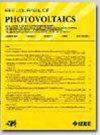顺序应力识别限制耐用性的双面光伏组件的加工缺陷
IF 2.6
3区 工程技术
Q3 ENERGY & FUELS
引用次数: 0
摘要
我们使用顺序应力来研究叠层缺陷对双面光伏(PV)组件耐久性的障碍。我们在改进的IEC 63209-2顺序应力下,使用乙烯醋酸乙烯或聚烯烃弹性体(POE)为基础的密封剂测试玻璃/玻璃(G/G)和玻璃/透明背板(G/TB)结构的迷你模块。该序列包括湿热(DH200),全光谱光暴露(A3),热循环(TC50)和湿度/冻结(HF10)的多次迭代。我们比较了室内压力和室外暴露。结果显示,在户外一年后,与我们的第一个压力周期相比,退化的相对趋势相似。随后的应力循环造成的损伤比这里使用的短时间室外暴露造成的损伤更严重。G/G微型模块中的边缘夹紧层合缺陷会导致层合剥离和电池裂纹,从而限制其耐久性。相反,当背板直接暴露在含紫外光下时,我们观察到与G/G在应力序列的后期阶段相比,G/TB迷你模块的降解更大。我们的研究结果强调了:1)连续应力测试的效用,以揭示双面光伏的退化模式,2)使用迷你模块测试光伏质量的意义,以及3)为了确保耐用性,必须避免层压缺陷的重要性,因为行业采用G/G或G/TB封装。本文章由计算机程序翻译,如有差异,请以英文原文为准。
Sequential Stress Identifies Processing Defects in Bifacial Photovoltaic Modules That Limit Durability
We use sequential stress to investigate hurdles to bifacial photovoltaic (PV) module durability from lamination defects. We test mini-modules with glass/glass (G/G) and glass/transparent-backsheet (G/TB) constructions using either ethylene vinyl acetate or polyolefin elastomer (POE) based encapsulants under a modified IEC 63209-2 sequential stress. This sequence includes multiple iterations of damp heat (DH200), full spectrum light exposure (A3), thermal cycling (TC50), and humidity/freeze (HF10). We compare indoor stress with outdoor exposure. Results show similar relative trends in degradation after a year outdoors compared to our first stress cycle. Subsequent stress cycles impart more severe damage than outdoor exposure for the short outdoor duration used here. Edge-pinch lamination defects in G/G mini-modules limit durability causing delamination and cell cracks. Conversely, we observe greater degradation in G/TB mini-modules compared to G/G in the later stages of the stress sequence when the backsheets are directly exposed to UV-containing light. Our results highlight: 1) the utility of sequential stress testing to uncover degradation modes in bifacial PV, 2) implications of using mini-modules for testing PV quality, and 3) the importance of lamination defects that must be avoided to ensure durability as the industry adopts G/G or G/TB packaging.
求助全文
通过发布文献求助,成功后即可免费获取论文全文。
去求助
来源期刊

IEEE Journal of Photovoltaics
ENERGY & FUELS-MATERIALS SCIENCE, MULTIDISCIPLINARY
CiteScore
7.00
自引率
10.00%
发文量
206
期刊介绍:
The IEEE Journal of Photovoltaics is a peer-reviewed, archival publication reporting original and significant research results that advance the field of photovoltaics (PV). The PV field is diverse in its science base ranging from semiconductor and PV device physics to optics and the materials sciences. The journal publishes articles that connect this science base to PV science and technology. The intent is to publish original research results that are of primary interest to the photovoltaic specialist. The scope of the IEEE J. Photovoltaics incorporates: fundamentals and new concepts of PV conversion, including those based on nanostructured materials, low-dimensional physics, multiple charge generation, up/down converters, thermophotovoltaics, hot-carrier effects, plasmonics, metamorphic materials, luminescent concentrators, and rectennas; Si-based PV, including new cell designs, crystalline and non-crystalline Si, passivation, characterization and Si crystal growth; polycrystalline, amorphous and crystalline thin-film solar cell materials, including PV structures and solar cells based on II-VI, chalcopyrite, Si and other thin film absorbers; III-V PV materials, heterostructures, multijunction devices and concentrator PV; optics for light trapping, reflection control and concentration; organic PV including polymer, hybrid and dye sensitized solar cells; space PV including cell materials and PV devices, defects and reliability, environmental effects and protective materials; PV modeling and characterization methods; and other aspects of PV, including modules, power conditioning, inverters, balance-of-systems components, monitoring, analyses and simulations, and supporting PV module standards and measurements. Tutorial and review papers on these subjects are also published and occasionally special issues are published to treat particular areas in more depth and breadth.
 求助内容:
求助内容: 应助结果提醒方式:
应助结果提醒方式:


